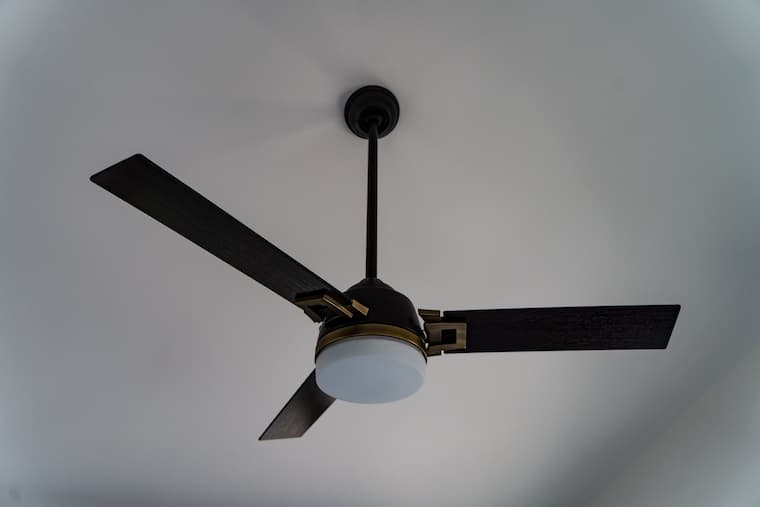Home & Garden
How To Choose the Right Ceiling Fan: Upgrade Your Home Décor and Save on Energy Cost Year-Round
Whether you need a strong draught, a light breeze, or something in between, a fan is a great solution for your problem. With summer around the corner, we’re all trying to determine the most cost-effective way to keep our houses cool. I’ve found that the traditional ceiling fan is the ideal option when looking for a useful and fashionable cooling fixture.
While many of us naturally grab an air conditioner, this is not the most energy-efficient option. It is a household essential where form and function coexist. It keeps you warm in winter and cool in summer, and ranges from classic and elegant to stunning minimalist models. Here are a few bits of advice that will help you select the ideal fan(s) for your home!
What’s the Ideal Style?

In the past, fans looked like uniform robotic devices with a single purpose – to keep your house cool. However, modern ceiling fans come in a wide range of beautiful designs that effectively regulate the temperature in your home and improve your décor game. Manufacturers are mixing different colours, styles, and shapes to create statement fans that are stylish as they are practical.
Look at your home’s interior design and select those designs that fit well in it. If you’re shopping for a large room, get a fan with big curvy fins to complement the whole aesthetic. A statement piece like this makes for a great conversation topic for a living room meant for entertaining. If your ceiling is high, a bolder kind of fan will emphasize the height of the ceiling and make you look up.
For smaller spaces, choose streamlined aesthetic ceiling fans online that blend in with the room and don’t make it look cluttered. When it comes to the materials used to construct fans, they come in metal, acrylic, glass, wood, and sometimes even fabric. While they all look equally stunning, your choice depends on which elements are prevalent in your interior.
A great thing about latest fans is that they also work as lighting for any room. Most models have a built-in lighting option and double up as light fixtures in your home. You can control the lights individually, allowing the fan to stay off even while the light is on!
Consider the Size of the Fan
Size means a lot when you’re shopping for this kind of fan. While a huge model in a small space will provide an overwhelming amount of airflow, a tiny one in a large room will have to work twice as hard to keep you cool. Choose a fan with 120 cm blades for a small to medium-sized space up to 4m x 5m, and 132cm or longer blades for a room up to 6m x 6m. For a larger room, you might need to use two or more fans.
Positioning is Everything

Blades must be at least 2.1m above the floor, so if your ceilings are low or average, you’ll need to hunt for a low-profile model that can blend in with the ceiling. Many of the ceiling fans for sale have a ball canopy mounting system which allows you to install them on sloped, vaulted, or flat ceilings. If you have a high ceiling, you might need an extension rod to lower the fan to an appropriate height.
If you’re getting a single fan, make sure to position it in the centre of the room. For a spacious bedroom, it’s practical to position your fan over the bed to provide cooling on warm evenings. Consider placing fans in “zones” in a large, open space, such as sitting areas and one above the dining tables.
Be mindful that to minimize flickering you need to install your fan securely to joists or blocks and it should be far enough from downlights. This distance depends on the distance between the ceiling, the fan, and the lighting angle coming from your downlights. For further guidance, it’s best to consult your electrician.
What are the Benefits of Using a Ceiling Fan?
Fans keep your space cool in the summer and warm in the winter. Your body uses perspiration to cool itself, so the faster the air rushes over your skin, the harder it works to evaporate it.
The power requirements of a ceiling fan are far lower than those of an air conditioner and pairing them both can significantly reduce your energy use. By lowering the room’s starting temperature and then circulating the cool air, the two effectively complement one another.
In contrast, there are comparable advantages during the winter when reverse-function fans can operate clockwise, forcing down the available heat more effectively — a bonus for spaces with high ceilings and even outdoor spaces.
This feature transforms your outdoor area into the ideal party space all year round when combined with high outdoor heaters. Using ceiling fans at outdoor spaces provides benefits beyond just cooling and heating. When entertaining guests, fans can keep flies from landing on your food since they dislike moving air.
A fan uses far less energy to operate than an air conditioner. The best modern fans for ceiling use a small portion of the energy that an air conditioner does. Although they seem to be among the easiest cooling devices, you should still take proper care and maintenance of them and use them properly.

















